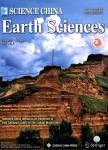Enrichment mechanisms of rare earth elements in marine hydrogenic ferromanganese crusts
Enrichment mechanisms of rare earth elements in marine hydrogenic ferromanganese crusts作者机构:Key Laboratory of Marine Oil and Gas Resources and Marine Environment Ministry of Land and Resources Qingdao China Qingdao Institute of Marine Geology China Geological Survey Qingdao China Institute of Resources and Environment Shandong University of Technology Zibo China Institute of Oceanology Chinese Academy of Sciences Qingdao China Department of Oceanography Xiamen University Xiamen China
出 版 物:《Science China Earth Sciences》 (中国科学(地球科学英文版))
年 卷 期:2011年第54卷第2期
页 面:197-203页
核心收录:
学科分类:08[工学] 0708[理学-地球物理学] 0824[工学-船舶与海洋工程] 0704[理学-天文学]
基 金:supported by National Natural Science Foundation of China (Grant No. 40076015) China Ocean Mineral Resources R & D Association
主 题:rare earth elements hydrogenic ferromanganese crust selective extraction experiment geochemistry combinationmechanism
摘 要:A series of selective extraction experiments were conducted on marine hydrogenic ferromanganese crusts from the seamount near the Line Island to investigate the distribution of rare earth elements (REEs) and the mechanisms of combination between REEs and the hydrogenic ferromanganese crusts. The enrichment of REEs in hydrogenic ferromanganese crusts is attributed mainly to the mineral or oxide/hydroxide of the crust rather than the growth environment. The REEs are present mainly in amorphous ferric oxide/hydroxide rather than in 6-MnO2. Amorphous ferric oxide/hydroxide preferentially combines free REE3+, while 6-MnO2 combines the REE-carbonate complexes in modern seawater. The REEs in seawater are combined more strongly with amorphous ferric oxide/hydroxides than with 6-MnO2. The positive Ce anomaly in hydrogenic ferromanganese crusts results from the oxidation of soluble Ce3+ to insoluble Ce4+ by the actively soluble oxygen of the bottom current rather than by the oxidation of δ-MnO2.



